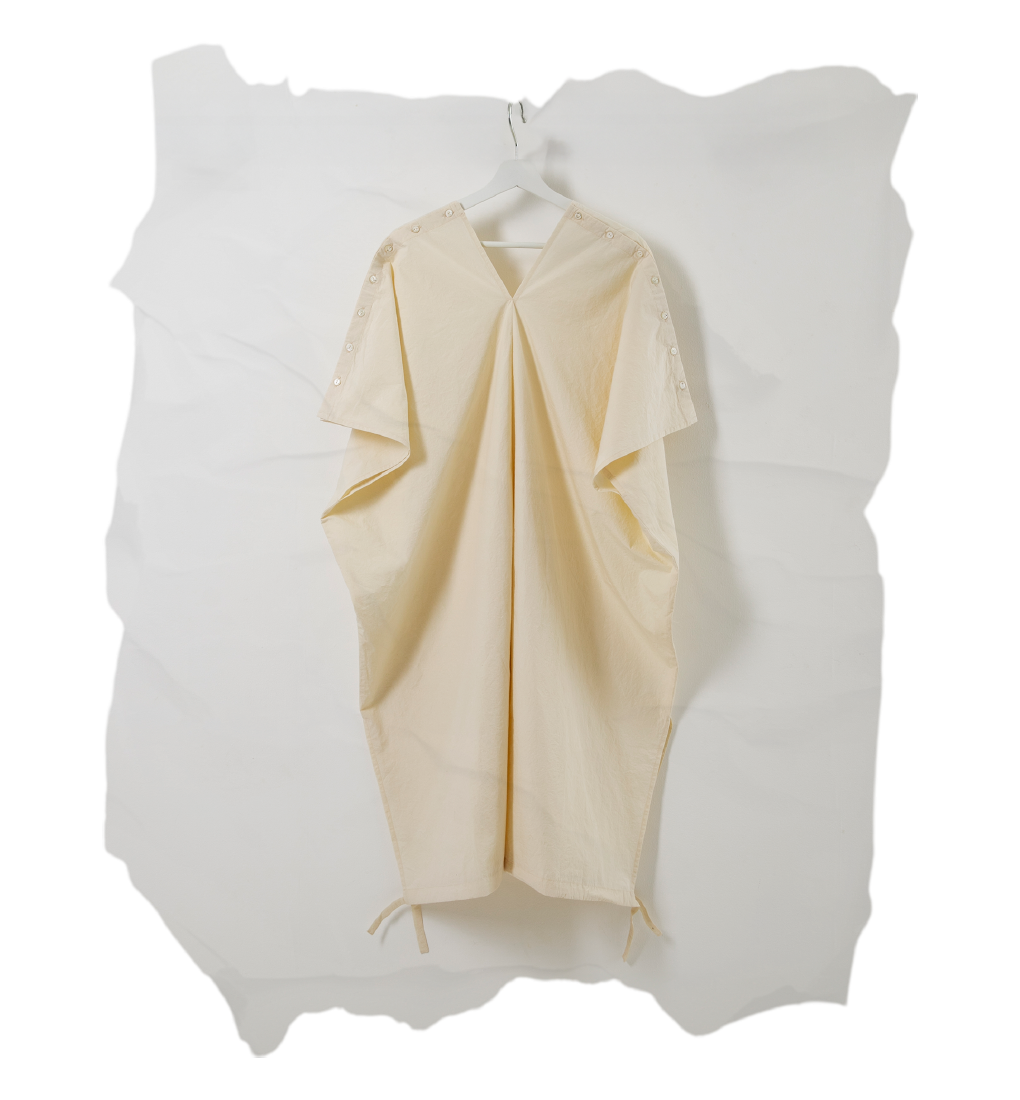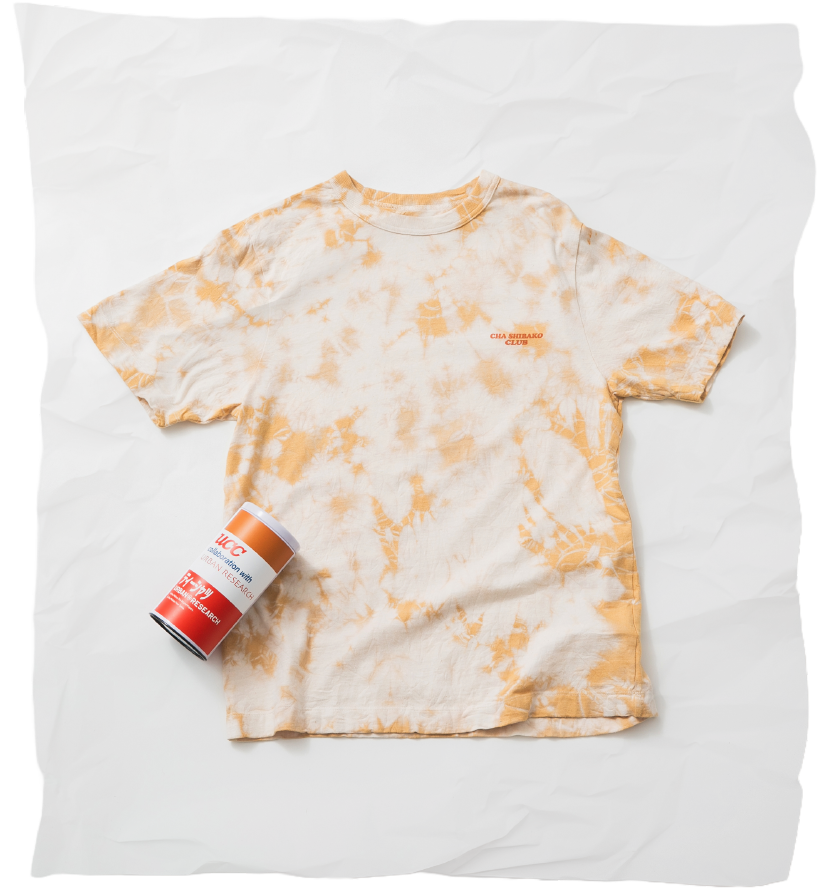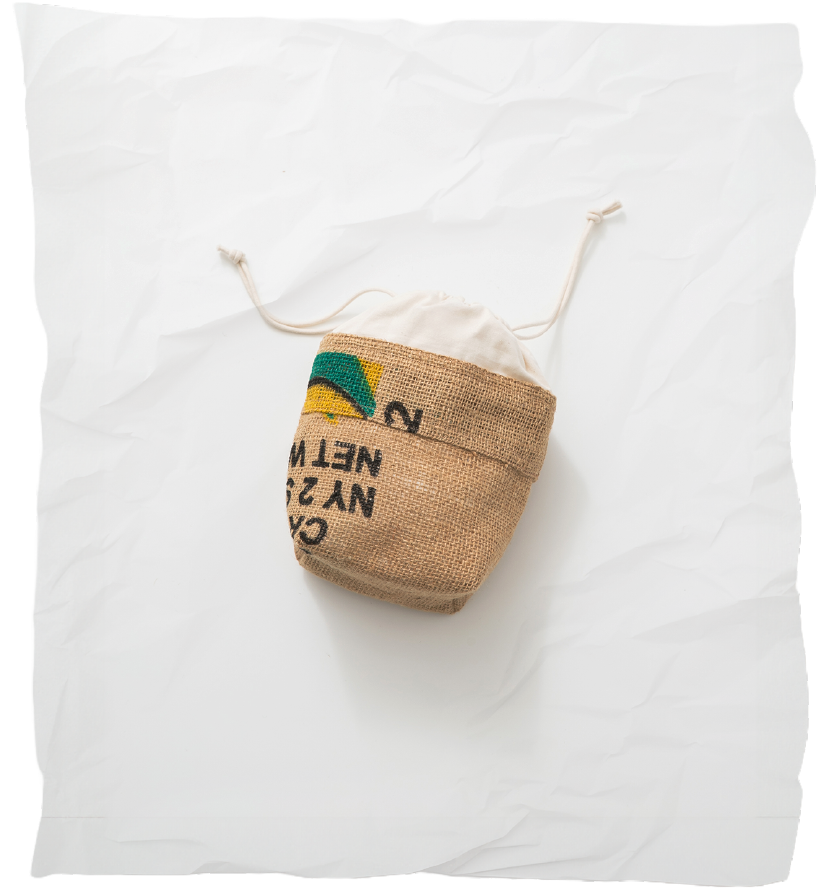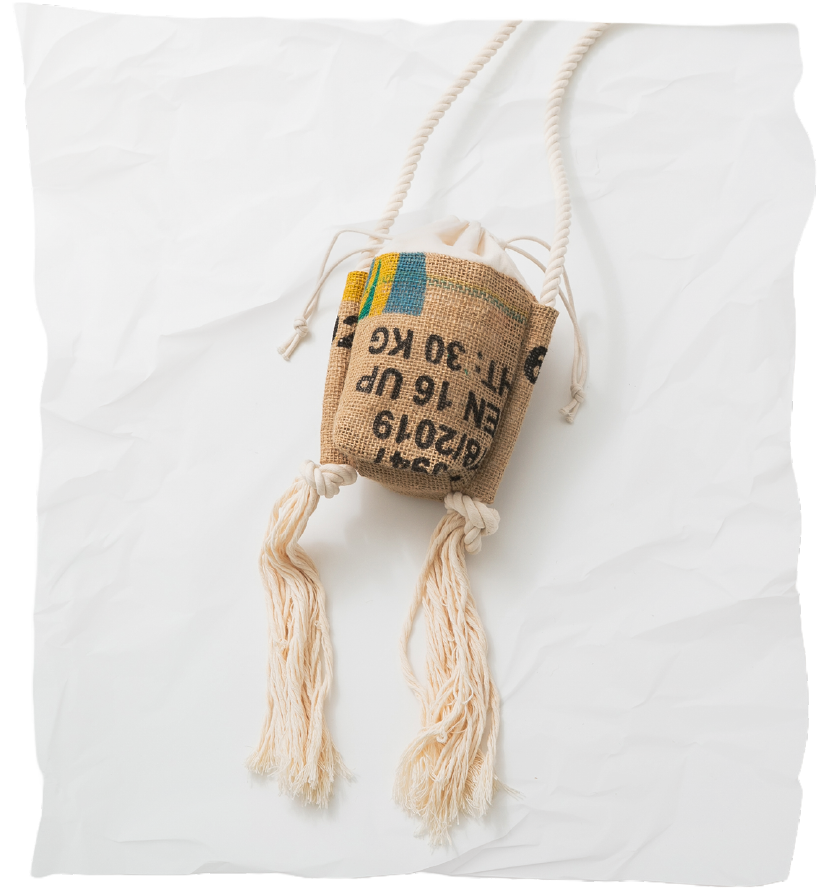土に還る服
Clothes that return to the earth
「衣・食・住」という言葉があるように、ファッションと食は昔からライフスタイルを形づくる大切な要素として語られてきました。けれど今、その境界は少しずつ溶けはじめています。その背景にあるのが、“循環”という価値観の広がりです。私たちが注目したのは、「Syncs(シンクス)」の取り組み。不要になった衣服を堆肥にし、土に還す。その土は、やがて野菜や果物を育てる栄養となる——つまりファッションが命を育む力になるのです。この循環の美しさに共感した私たちは、シンクスとともに“土に還る服”の制作に取り組みました。
衣類は今や、ただのモノではなく、未来へとつながる資源。食とファッションが地続きになるこの時代、「衣・食・住」という言葉の関係も、やがて新しい形へと姿を変えるかもしれません。
Just as the phrase “clothing, food, and shelter” suggests, fashion and food have long been regarded as essential elements that shape our lifestyles. However, the boundaries between them are gradually beginning to blur. At the heart of this shift is the growing value placed on circulation—a more sustainable, regenerative approach to living.
One initiative that caught our attention is that of Syncs. They turn discarded clothing into compost, returning it to the earth. That soil then nourishes vegetables and fruits—fashion, in this cycle, becomes a source of life itself. Moved by the beauty of this idea, we collaborated with Syncs to create garments designed to decompose and return to the soil.
Clothing is no longer just a product—it’s a resource that connects us to the future. In an era where food and fashion are beginning to merge, the traditional concept of “clothing, food, and shelter” may soon take on a whole new meaning.
再生 PLAY
再生 PLAY
再生 PLAY
再生 PLAY
洋服を土に還す、ということ
「Syncs(シンクス)」との協業
Collaboration with Syncs
大量の物質で溢れる現代社会。ファッションを生業とする私たちにも、もちろんその責任は伴います。ファストファッションの浸透とともに目まぐるしく変わるトレンドと、それにともなう大量の衣類の消費と廃棄。ファッションに携わる者として、無視することのできないこの現実です。この問題に対してシンクスは「洋服を土に還す」という方法でひとつの答えを提示しました。廃棄物として終わるはずだった服が、再び命を育む資源になる。この新たな価値観に共鳴した私たちは、シンクスの先導のもと、土に還る服のプロジェクトを推進します。
In today’s society, where we are surrounded by an overwhelming abundance of material things, those of us who work in fashion must also recognize our role and responsibility. The rise of fast fashion has brought with it rapidly shifting trends—and, in turn, mass consumption and disposal of clothing. As people involved in the fashion industry, this is a reality we can no longer ignore.
Syncs has offered one powerful answer to this issue: returning clothing to the soil. Garments that would otherwise end their lives as waste are transformed into a resource that nurtures new life. Resonating deeply with this new value system, we are joining Syncs in advancing a project to create clothing designed to return to the earth.
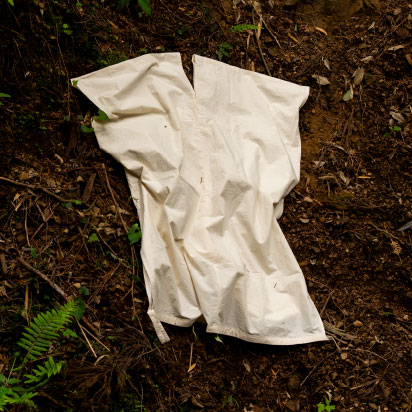
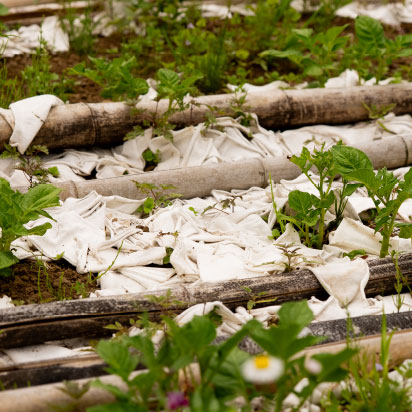
会場で実際に見て触れるコラボレーションアイテム
Collaboration items you can actually see and touch at the venue.
今回、アーバン博会場で実際に見てもらえるコラボアイテムは、日本の伝統技である法被に現代らしいエッセンスを加えた羽織と、素朴な貫頭衣をデザインベースとしフォークロアの雰囲気を纏うワンピースの2型です。いずれも無染色のオーガニックコットンをベースに、縫製糸も綿素材を採用しています。ご愛用いただいた後は、堀江にあるTHE GOODLAND MARKETまたはシンクスにて回収を承り、その後、シンクスが運営する畑の土に混ぜて堆肥化、再利用させていただきます。
This time, the collaboration items you can see in person at the "URBAN-PAKU" venue include two designs: a haori jacket that adds a modern touch to the traditional Japanese happi coat, and a folkloric-style dress based on the simple design of a kantoui (a traditional tunic). Both pieces are made from undyed organic cotton, with cotton thread used for stitching as well.
After use, you can return the items at THE GOODLAND MARKET in Horie, Osaka or at Syncs. They will then be composted and reused by mixing them into the soil at a farm operated by Syncs.
素材は無染色のオーガニックコットンで、縫い糸も綿素材を使用。
日本の伝統衣装の1つでもある「法被(はっぴ)」から着想を得てうまれたアイテム
法被らしい要素を残しつつ、現代のスタイルに合わせたデザインが特徴で襟元や裾などにあるドローコードで着用感を自在にアレンジいただけます。
Syncsまたはアーバンリサーチ(THE GOODLAND MARKET)で着古したアイテムを回収。生分解させることで堆肥として地球に還していきます。
The material used is organic cotton without dyeing, and the sewing threads are also made of cotton. This item was inspired by the Happi, one of Japan's traditional costumes. While retaining the elements typical of happi coats, the design is characterized by its modern style, and the drawcords at the collar and hem allow the wearer to freely adjust the feel of the garment. Earth or Urban Research (THE GOODLAND MARKET) to collect worn-out items, aiming to realize zero-waste.
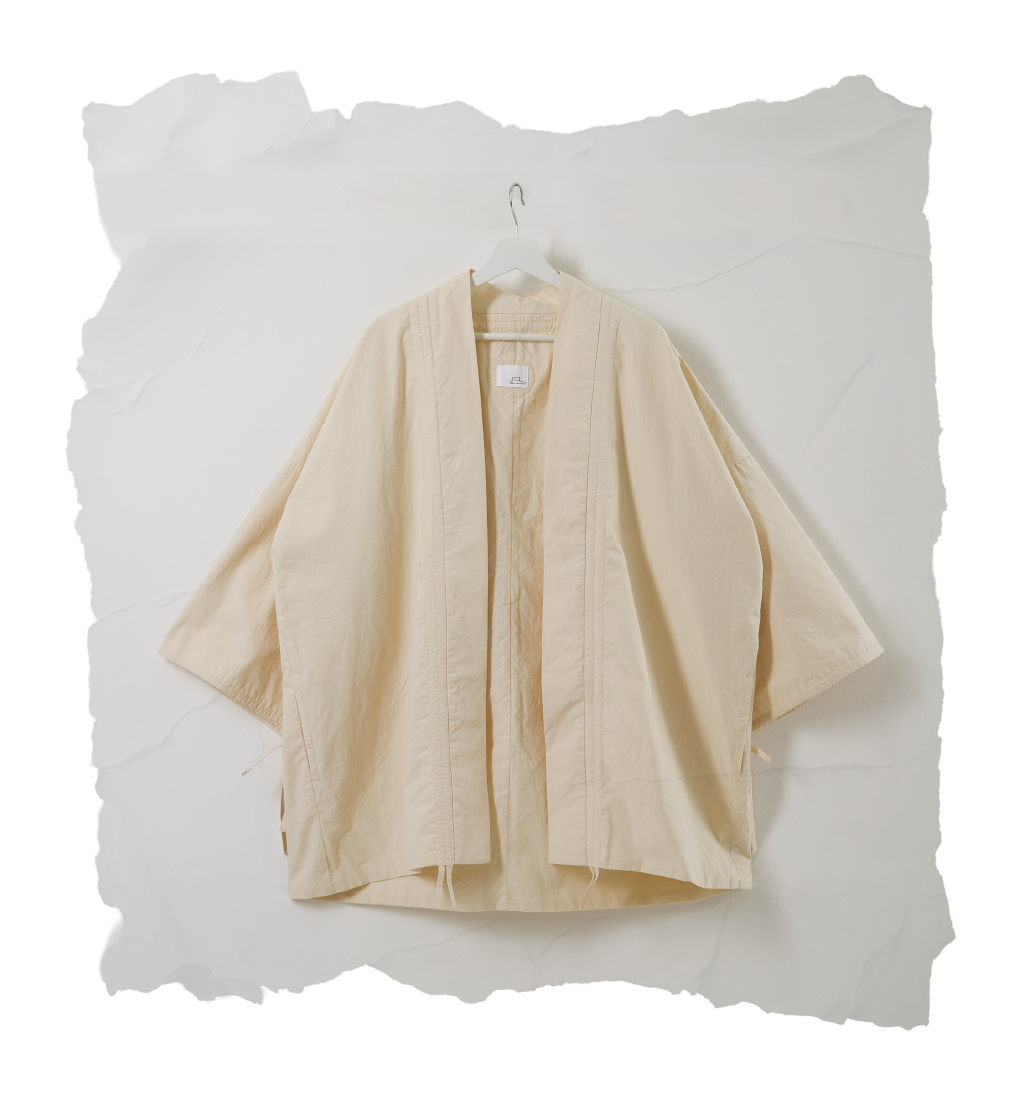


UCC
クリエイティブな発想は、
いつもコーヒーから
再生 PLAY
再生 PLAY
再生 PLAY
再生 PLAY
「より良い世界のために、コーヒーの力を解き放つ」をテーマに、コーヒーの新たな可能性を追求し、これまでにない価値創造に挑戦する企業「UCC上島珈琲株式会社」。今回のアーバン博では、同社とのコラボレーションアイテムも展開します。
UCCといえば、1969年に世界初の缶コーヒーを開発したパイオニアメーカー。当時販売されていた「UCCコーヒーミルク入り」(現:UCCミルクコーヒー)は、大阪万博(EXPO’70)をきっかけに一躍注目を集め、ワールドスタンダードな存在へと押し上げられました。そんな万博とも深い縁を持つ同社とのコラボレーションは、アーバン博で私たちが掲げる「食とファッションの結びつき」を体現する、重要なセンテンスとなっています。
With the theme “Unleashing the Power of Coffee for a Better World,” UCC is a company that explores new possibilities for coffee and takes on the challenge of creating unprecedented value. At this year’s Urban Expo, we are also showcasing collaboration items with UCC.
Known as the pioneer that developed the world’s first canned coffee in 1969, UCC gained widespread attention with its “UCC Coffee with Milk,” especially after the Osaka Expo (EXPO ’70), which helped propel the product to global recognition. This collaboration with a company so deeply connected to the Expo holds special significance—it serves as a key expression of the Urban Expo’s core message: the fusion of food and fashion.
UCCと一緒に取り組むアップサイクル
Upcycling in collaboration with UCC
缶コーヒーを発明したUCC。その柔軟な創造性は、抽出後のコーヒー粉を再利用する環境対策の姿勢にも見られます。飲み終わった後に残るコーヒー粉は主に、燃料や堆肥、再生紙や陶器の釉薬、染料など、さまざまな思いもよらないものへと姿を変えているからです。中でも、私たちが得意とする“洋服”との相性が良いのは、やはり染め。そこで今回のアーバン博では私たちと同じく関西企業であるUCCとの共創により、 コーヒー染めを施したTシャツを販売します。しかもEXPO’70で世界に羽ばたいたUCCミルクコーヒーを模したケース入り。しかもEXPO’70で世界に羽ばたいたUCCミルクコーヒーを模したケース入り。ノスタルジックなパッケージと、コーヒー染めの温かみのある色合いが絶妙にマッチしています。さらにコーヒー豆を輸入する際に使う麻袋を使った巾着バッグとボトルバッグも同時発売となり、まるでミルクとシロップが添えられたかのような、コーヒーのタイニーコレクションが完成!
食とファッションをつなぐこの取り組みは、前回の大阪万博をどこか懐かしく想起させる、“仕掛け”のあるアイテムへと昇華しました。
URBAN RESEARCH EXPO2025 STORE、UCC公式オンラインストアで数量限定発売です。
UCC, the pioneer that invented canned coffee, showcases its flexible creativity not only through innovation but also through its environmental efforts—specifically, the upcycling of spent coffee grounds. These used grounds are repurposed in unexpected ways, becoming fuel, compost, recycled paper, ceramic glaze, dye, and more.
Among these possibilities, dyeing stands out as especially compatible with what we do best: clothing. That’s why, with full support from UCC, we’re offering coffee-dyed T-shirts at this year’s Urban Expo. Packaged in nostalgic cans modeled after the original UCC canned coffee that made its global debut at EXPO ’70, the warm, earthy tones of the coffee dye pair perfectly with the retro-style packaging.
Also available are drawstring and bottle bags made from burlap sacks used to import coffee beans. The result is a tiny coffee-themed collection—like adding milk and syrup to your coffee—that blends charm and sustainability.
This initiative, which connects food and fashion, has evolved into a collection of items filled with thoughtful design touches—nostalgic reminders of the previous Osaka Expo, and a creative “twist” that brings the past and present together.
Available in limited quantities at URBAN RESEARCH EXPO2025 STORE and UCC official online store.
家でも簡単にできる“抽出後のコーヒー粉”の再利用
Easy ways to reuse spent coffee grounds at home
コーヒー染めは抽出後に残るコーヒー粉や古くなったインスタントコーヒーを使うことで家庭でも簡単にできます。色の定着を促すタンパク質液(牛乳や豆乳)に浸けて乾かしたら、抽出後のコーヒー粉をさらに煮出した抽出液に浸し染色。最後に塩水などに浸して色止めしたら、すすいで乾かし完成です。ざっくりとですが、これだけの工程で簡単にコーヒー染めは楽しめます。UCCの公式サイトでは、染め方の工程が丁寧に書かれていますので、今回のコラボアイテムでコーヒー染めに興味を持たれた方は、ぜひそちらをチェックしてみてください!
Coffee dyeing can be easily done at home using spent coffee grounds or even old instant coffee. First, soak the fabric in a protein solution (such as milk or soy milk) to help the color set, and then let it dry. Afterward, immerse the fabric in a dye bath made by boiling the used coffee grounds to extract the color. Finally, soak the fabric in a saltwater solution to fix the color, rinse it, and let it dry. These simple steps are all you need to enjoy coffee dyeing at home.
For those who are interested in coffee dyeing through this collaboration, UCC’s official website offers a detailed guide on the process. Be sure to check it out!
